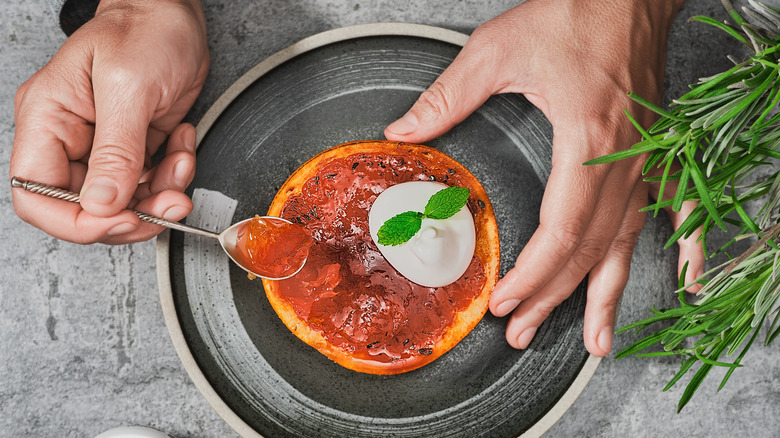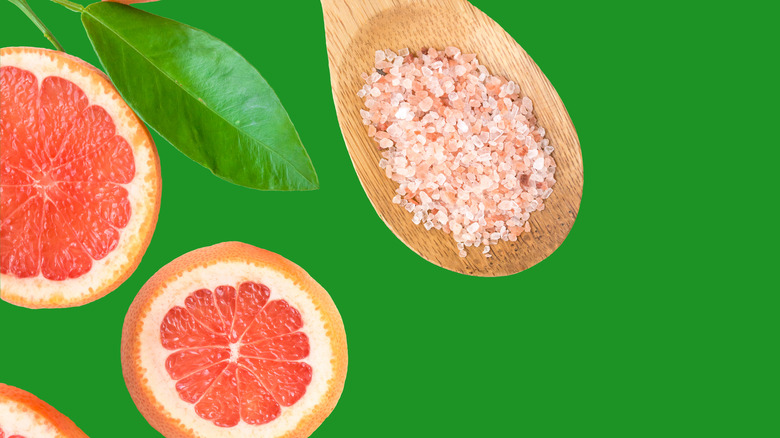How To Fix The Bitter Taste In Grapefruit
Grapefruits have beautiful pink or golden flesh, tons of juice, and a bright aroma, but what can taste interesting, tart, mildly sweet, and pleasantly bitter to some may be unpalatable to others. If you are not used to the taste, or if you are particularly sensitive to bitter flavors, grapefruit may be completely off the table. However, there are several different strategies that can help you fix that bitter taste starting with the actual variety that you choose to purchase.
Oro blanco grapefruits are the sweetest of the bunch and have very little bitterness, but they also lack much of that characteristic tartness. Most of the grapefruits that are consumed — around 75% — are red, so this variety can sometimes be hard to find, but it is a great option for those who are after as little bitterness as possible. Red grapefruits are also not as bitter as pink and white grapefruits, but that sweeter flavor profile also creates less complexity of flavor.
How you cut a grapefruit matters
That sharply bitter flavor in grapefruit comes from a flavonoid compound called naringin. While there is some naringin in the flesh of the fruit, most of it lives in the membrane, spongy pith, and outer zest. Because of this, it is not ideal to peel a grapefruit by hand and eat the whole segments like you would with an orange. Having each wedge encased in skin introduces way too much bitterness. It is a little tedious, but you are better off slitting open each section and peeling off the membrane segment by segment. Alternatively, cut the grapefruit in half along the equator. Then, use a sharp paring knife to cut along either side of each segment. You can also use a handy double-blade grapefruit knife to make this step go a little faster. After you have cut around each piece of fruit, you can simply scoop it out with a spoon.
You can also cut citrus fruit into tender, juicy supremes. Cut off both ends of the grapefruit so it can sit upright on your cutting board. Using a sharp knife, cut along the curve of the fruit from top to bottom, and remove the zest and pith like you are peeling a whole pineapple. Then, hold the peeled grapefruit, and cut along either side of each line of membrane to remove each segment.
Add sugar to counteract grapefruit's bitterness
No matter how you cut it, a little sugar can go a long way in fixing the bitter taste of the grapefruit. It makes sense that sugar can help to mask bitter flavors — consider coffee, tea, chocolate, alcohol, cranberry sauce, or candied citrus peels, for example. Grapefruit too can benefit from a sprinkle of sugar, a spoonful of honey, or a drizzle of maple syrup.
A really delightful way to enjoy this combination is in a grapefruit brûlée. Sprinkle a halved grapefruit with sugar, and then pop it under the broiler for a couple of minutes. Just keep a close eye on it because melting sugar can go from perfectly golden to totally burnt in just a few seconds. The sugar creates a delectable, crunchy shell, and the warm fruit softens slightly and starts to release its natural juices. If you have one, you can also use a handheld blow torch to quickly melt sugar to avoid messing with a finicky broiler.
Salt can sweeten the deal
Adding a sprinkle of salt is another way to make grapefruit taste less bitter. It may seem counterintuitive, but salting grapefruit tricks your taste buds and makes you perceive the fruit to be sweeter. It is not that the grapefruit is not sweet at all, but that the bitterness just overpowers it. Gary Beauchamp of the Monell Chemical Senses Center explains to NPR that "the ions in the salt ... block many of the receptors on our tongues that detect bitterness." The sweetness is then able to take center stage on the palate. Salt may also cause more of the aromatic compounds of the fruit to be released, too. Since smell is such a huge part of how humans experience flavor, the amplified fruity scent can also impact how sweet it tastes.
With a very light sprinkle of salt, the grapefruit's flavors will shine without tasting overtly salty. You can also take a page from culinary traditions that commonly combine salt and chilies to sprinkle on fruit with Mexican Tajín, Thai prik-kab-klua, or Vietnamese muối ớt.
Pair grapefruit with balancing flavors
It is impossible to completely get rid of the bitter taste of grapefruit, and frankly, the fruit would probably fall a little flat if it had no bitterness at all. Consider pairing grapefruit with complimentary flavors that help to balance out the flavor profile. This can be as simple as making a fruit salad with other types of citrus like tangerines and blood oranges — or tossing grapefruit segments with sweeter fruits like bananas, berries, strawberries, or peaches.
The introduction of fat can also help balance bitterness. Yogurt can definitely do the job whether that is in a yogurt bowl topped with grapefruit or blended into a creamy smoothie. You can also go savory and pair grapefruit with fatty avocado, fresh mint, and thinly sliced chilies for a deliciously bright salad. Make the dressing using several ingredients that help counteract bitterness with grapefruit juice, neutral oil, a little honey, and some fish sauce for a hit of umami saltiness.





